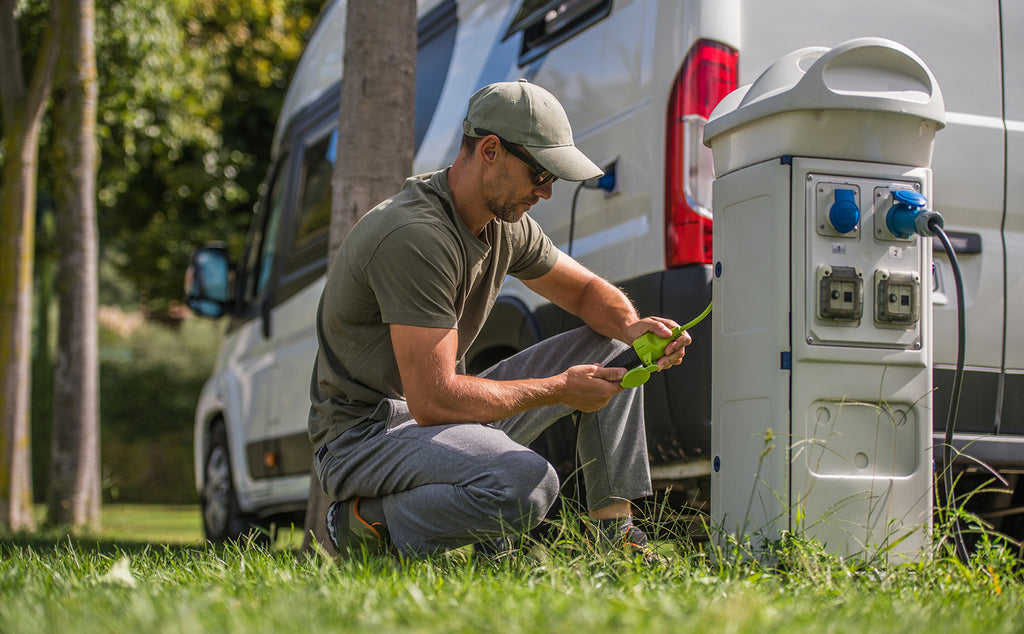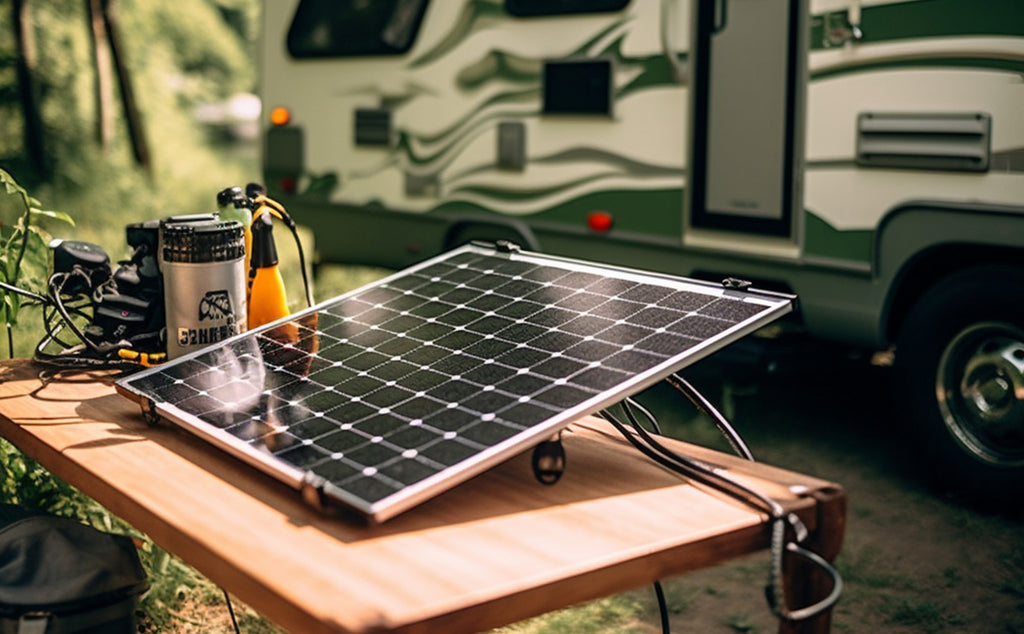| Feature | 30-Amp Service | 50-Amp Service |
|---|---|---|
| Electrical Capacity | Provides 3,600 watts through a single 120-volt line | Delivers 12,000 watts via two 120-volt lines |
| Power Output | Suitable for basic functions like lighting, charging small devices, and operating one major appliance at a time | Supports multiple high-demand appliances simultaneously, such as dual AC units, large heaters, and kitchen appliances |
| Outlet Configuration | Three-prong plug: one 120-volt hot wire, one neutral wire, and one ground wire. Plug is cylindrical and simple | Four-prong plug: two 120-volt hot wires, one neutral wire, one ground wire. Plug is larger and geometrically complex |
| RV Compatibility | Ideal for smaller RV setups with limited power needs. Requires careful power management to avoid tripping breakers | Suited for larger RVs with extensive power requirements, allowing a broader use of appliances without overloading |
When managing power needs for recreational vehicles (RVs), it is crucial to understand the differences between 30-amp and 50-amp electrical services. These distinctions are not only about capacity; they shape what appliances you can operate in your RV and how you manage your overall energy consumption. This article delves into the specific characteristics of 30-amp versus 50-amp services, highlighting their impact on RV connectivity, the need for adapters in various setups, and how these factors contribute to a safe and efficient RV experience.
30-Amp vs. 50-Amp RV Service
When comparing 30-amp and 50-amp RV services, it's important to understand their key specifications and how they impact the functionality of an RV.
Electrical Capacity:
- 30-Amp Service: Provides electricity through a single 120-volt line. Maximum power output is 3,600 watts, which is adequate for running basic RV functions like lighting, charging small devices, and operating one major appliance such as an air conditioner or a small heater independently of other high-demand devices.
- 50-Amp Service: Delivers power via a 240-volt supply, split into two 120-volt lines, for a total output of up to 12,000 watts. This capacity supports simultaneous use of multiple high-demand appliances, including dual air conditioning units, large electric heaters, and high-powered kitchen appliances.
Outlet Configuration:
- 30-Amp Outlets: These outlets accommodate a three-prong plug configured with one 120-volt hot wire, one neutral wire, and one ground wire. The plug shape is typically cylindrical and less complex, making it distinguishable.
- 50-Amp Outlets: Equipped with a four-prong plug that includes two 120-volt hot wires, one neutral wire, and one ground wire. The design allows for the handling of 240 volts, evident in its larger size and more intricate geometric plug shape.
RV Compatibility and Considerations:
- 30-Amp RVs: Best suited for smaller RV setups that require limited power. The single 120-volt line restricts simultaneous high-wattage appliance use, making power management crucial to avoid tripping the circuit breaker.
- 50-Amp RVs: Designed for larger RVs with extensive power needs. The dual 120-volt lines facilitate a broader range of appliance usage at once, enhancing comfort and convenience without the risk of overloading the system.
Can a 30-amp RV Be Connected to a 50-amp Port?
Connecting a 30-amp RV to a 50-amp port is technically feasible but requires a specific adapter. This adapter, often called a "dogbone," connects the 30-amp plug of the RV to the 50-amp outlet, safely matching the RV's system to the campground's higher-capacity power source. However, while this setup allows for a connection, it does not increase the RV's capacity beyond its 30-amp limits; hence, overloading the RV's electrical system is still a risk if too many appliances are used simultaneously.
How Do I Know if My RV is Equipped for a 30-Amp or 50-Amp Service?
Determining whether your RV is equipped for a 30-amp or 50-amp service involves checking a few specific components of your RV's electrical system. Here's what you need to look for:
- Power Inlet: The most visible indicator is the type of plug your RV uses. A 30-amp plug typically has three prongs – one 120-volt hot wire, one neutral, and one ground, shaped in a cylindrical form. A 50-amp plug will have four prongs – two 120-volt hot wires (providing 240 volts), one neutral, and one ground, often more complex in shape and larger than the 30-amp plug.
- Main Circuit Breaker: Open your RV's circuit breaker panel and check the main breaker. A 30-amp service will usually have a single 30-amp main breaker, while a 50-amp service will feature a double-pole main breaker that can handle up to 50 amps per pole.
- Owner's Manual: The RV's owner's manual should specify the service for which it is rated. This is a reliable source of information if you are unsure about the physical characteristics of the outlets or breakers.
- Service Panel: Examine the RV's service panel; it should indicate whether it is designed to handle 30 or 50 amps. Panels equipped to manage 50 amps often support more branch circuits.
- Wiring Size: Although this is more technical and might require professional assistance, 50-amp services typically use thicker wiring than 30-amp services to safely handle the higher current.
Identifying whether your RV is designed for a 30-amp or 50-amp service is crucial for safe and efficient power use. Connecting your RV to the correct type of power supply prevents potential electrical hazards and ensures that all your RV's systems function optimally. If you're still in doubt after these checks, consider consulting with a professional electrician or an RV technician.

Can a 50-Amp RV be hooked up to a 30-Amp port?
Hooking a 50-amp RV to a 30-amp port also requires an adapter. However, this situation is more restrictive because the power available is limited to 30 amps. Owners of 50-amp RVs need to be cautious about their power usage to avoid tripping the circuit breaker. Running multiple high-energy appliances at the same time is not advisable under this setup.
Can I Plug My RV into a 15-amp Home Electric Outlet?
Connecting an RV to a 15-amp home electric outlet is possible but comes with significant limitations. Using an adapter, you can connect your RV's electrical system to a standard household outlet. However, the available power is minimal, generally sufficient only for low-demand tasks like charging batteries or running a few lights. Appliances such as air conditioners or microwaves may exceed the capacity of a 15-amp outlet, potentially leading to circuit breaker trips.
Do I Need an Adapter to Connect An RV to a Generator?
The need for an adapter when connecting an RV to a generator depends on the matching outlet types and the electrical capacities involved. If the generator's outlet and the RV's plug match in type (30-amp to 30-amp, 50-amp to 50-amp), then no adapter is necessary. However, if the configurations differ, an appropriate adapter is required to make a safe and effective connection.

Do I Need a Surge Protector for RV Service?
Using a surge protector for your RV service is highly recommended to safeguard your vehicle's electrical system against unexpected voltage spikes and power fluctuations. Here's why a surge protector is essential and what you should consider:
- Protection Against Electrical Surges: RVs are particularly vulnerable to electrical surges from lightning strikes, faulty wiring, or issues with campground power supplies. A surge can damage anything plugged into the electrical system, from appliances to sensitive electronic devices.
- Voltage Regulation: Quality surge protectors not only shield against surges but also help manage low voltage and electrical spikes that occur. This is especially important when your RV is connected to less reliable power sources that may experience frequent voltage fluctuations.
- Preserving Appliance Lifespan: Consistent exposure to unstable power can degrade the life of an RV's electrical appliances over time. Using a surge protector helps ensure that the voltage supplied to your appliances remains within a safe range, thereby extending their lifespan.
- Preventive Safety Measure: Surge protectors often come with indicators that provide warnings about faulty power supplies, such as open grounds, reverse polarity, or excessive voltage, allowing you to address the issue before connecting your RV.
- Choosing the Right Surge Protector: Select a surge protector that matches the amperage of your RV's service. If your RV is equipped with a 30-amp service, use a 30-amp surge protector, and for a 50-amp service, choose a 50-amp protector. Ensure it can handle the maximum voltage your RV may encounter, and look for models that offer features like weather resistance and easy-to-read displays.
Incorporating a surge protector into your RV's electrical setup is a small investment that can prevent costly repairs and replacement of appliances while enhancing safety during your travels.
The Bottom Line
Choosing the appropriate electrical service for your RV-whether 30-amp or 50-amp-depends fundamentally on your power requirements and how you intend to use your RV. Understanding the differences between these services is essential for efficiently managing your RV's energy needs, especially when connecting to campground utilities or adapting to alternative power sources. Always ensure safety and functionality by using the correct adapters and consulting with professionals to maintain the integrity of your RV's electrical system and prevent potential hazards.
Read More
- The Reliable Backup Power Solution To Prevent Grid Instability and Blackouts
- Choosing the Best Portable Power Station for Emergencies and Outdoor Adventures
- The Growing Popularity of Portable Power Stations: Why More People Are Choosing Them
- Can I Use a Generator in an Apartment?
- The Ultimate Summer Adventure Packing Guide: Essentials for Outdoor Fun & Safety












